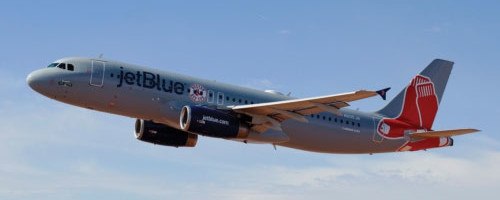Jet Blue: Bringing Humanity Back to Air Travel

JetBlue is a full service, low cost airline that serves as a great example of a company whose business model and operating model exist in harmony. At its’ inception, JetBlue’s hybrid full service, low cost business model shocked the traditional airline industry. However, the balance between customer service and investor demands have recently tested JetBlue’s true value proposition.
Company Background
Incorporated in 1998, JetBlue is the 5th largest airline in the United States. With its’ main base at JFK International Airport in New York, JetBlue serves 92 destinations in the United States, Caribbean, South America and Latin America.
Business Model
JetBlue pledg es to provide superior service in every aspect of their customer’s air travel experience. At a time when most airlines were cutting back on amenities, JetBlue took the industry by storm by offering the following amenities all free of charge: seatback DIRECTV, snacks and drinks, internet access, the most legroom in coach, and one checked bag. In addition to the amenities, JetBlue stands by a customer focused company culture that emphasizes personalized, friendly service that exceeds customer expectations. From the beginning they insisted that low cost and competing on price did not mean they have to deliver a poor customer experience.
es to provide superior service in every aspect of their customer’s air travel experience. At a time when most airlines were cutting back on amenities, JetBlue took the industry by storm by offering the following amenities all free of charge: seatback DIRECTV, snacks and drinks, internet access, the most legroom in coach, and one checked bag. In addition to the amenities, JetBlue stands by a customer focused company culture that emphasizes personalized, friendly service that exceeds customer expectations. From the beginning they insisted that low cost and competing on price did not mean they have to deliver a poor customer experience.
These amenities are all offered within the construct of JetBlue’s simple up-front pricing structure. Although unbundling allows airlines to exploit price discrimination to a great extent, some customers prefer the simple up-front price. In a time where fare comparison is easier than ever, the unbundling used by competitor airlines is often seen by customers as nothing more than a tool to disguise the final cost to the customer.
Operating Model
JetBlue’s operating model is designed around a low-cost operating structure. A young fleet of fuel efficient aircraft helps turn this low-cost promise into a reality. This structure combined with a predominantly point-to-point flight network enables the carrier to price fares lower than many of its’ competitors.
With regards to customer base, JetBlue is focused on growing the share of business travelers in order to boost its’ revenue by serving customers less susceptible to economic downturns. In concert with this, JetBlue is focused on continuing to grow presence in high-value core northeastern hubs such as New York and Boston.
Competitive Advantage
JetBlue’s success is not a result of their business model or operating model alone, but rather the seamless relationship between them. Separating JetBlue from the other low-cost airlines is their ability to offer a great line of amenities. As costs in the industry rise, they look at ways to maintain margins without sacrificing the customer experience. For example, JetBlue’s fuel efficient fleet helps counter rising employee costs facing the airline industry. Additionally, the introduction of the Mint program has allowed JetBlue to capture the willingness-to-pay of price insensitive customers, while maintaining their customer promise to the broader audience.
Likewise, what separates JetBlue from industry giants is their attractive price tag. As operating costs, such as fuel and employee payroll, have risen across the industry JetBlue has worked to ensure the increased costs are not passed on to the customer. A focus on increased growth in profitable geographies as well as additional catering to business travelers have allowed JetBlue to deliver on its’ customer promise while maintaining competitive prices.
The Future
During its inception, it is no surprise that JetBlue’s operating and business models were in sync. However, what truly makes JetBlue impressive is how it has stayed true to its value proposition across the years. Within the past 6 months, JetBlue has shocked some loyal customers by following the industry trend and charging for all checked baggage. It will be paramount to see how JetBlue customers react to this change, and furthermore, whether this is an anomaly or a sign that the harmonious relationship between the business model and operating model is coming to an end. Only time will tell.
http://marketrealist.com/2014/07/must-know-jetblues-competitive-airline-positioning/
http://www.wsj.com/articles/jetblues-plan-to-repair-its-brand-1424664612



Do you think that JetBlue has used customer loyalty programs (i.e. frequent flyer, credit cards) as effectively as other airlines? Is this something they could use to better overcome some of the pressures they are starting to face?
James, thanks for the comment. JetBlue is certainly not known for their loyalty programs but, as briefly mentioned above, they are adding additional features to appeal to the frequent business traveler. With the introduction of Mint, it allows those focused on loyalty programs to take advantage. Furthermore, they have introduced family pooling which allows up to 4 people (2 adults and 2 minors) to pool points together solving the age old problem of wasting points below the minimum redeemable amount. Although perhaps not appealing to frequent business travelers, I see this as a huge plus for those families that travel occasionally.